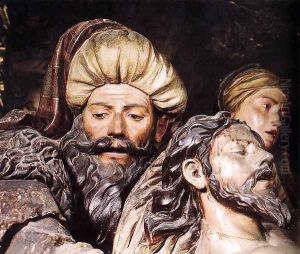Pedro Roldan Paintings
Pedro Roldán was a prominent Spanish sculptor and painter of the Baroque period, born in Seville in 1624. Roldán's work significantly contributed to the Andalusian school of sculpture, and he is considered one of the leading figures in Spanish Baroque art. His oeuvre is characterized by its dramatic intensity, emotional depth, and technical precision, qualities that made him a pivotal figure in the evolution of Spanish sculpture during the 17th century.
Roldán received his artistic training in Seville, a city renowned for its vibrant artistic community and its role as a center of the Spanish Baroque movement. His early work was influenced by his contemporaries in Seville, including Francisco de Zurbarán and Alonso Cano, but he soon developed a distinctive style that set his work apart. Roldán's sculptures are noted for their dynamic compositions, detailed drapery, and the expressive realism of the figures, which often convey a profound sense of spirituality and emotion.
Throughout his career, Roldán worked on numerous religious commissions, creating altarpieces, statues, and reliefs for churches and cathedrals across Andalusia. One of his most celebrated works is the Virgin of the Immaculate Conception for the Cathedral of Seville, which showcases his skill in capturing the beauty and grace of religious figures. Roldán's expertise was not limited to religious subjects; he also produced secular works, including portraits and mythological scenes, although these are less well-known today.
In addition to his accomplishments as a sculptor, Pedro Roldán played a significant role in the training of the next generation of artists. His workshop in Seville was one of the most important in the region, attracting numerous apprentices and students. Among them was his daughter, Luisa Roldán, who became one of the most celebrated female sculptors of the Spanish Baroque. Pedro Roldán's influence extended beyond his immediate circle, as his approach to sculpture helped shape the development of Baroque art in Spain and its territories.
Pedro Roldán passed away in 1699, leaving behind a legacy that had a lasting impact on Spanish art. His works continue to be admired for their emotional power, technical mastery, and their contribution to the Baroque aesthetic. Roldán's sculptures remain key highlights in the collections of many churches, cathedrals, and museums in Spain, testament to his enduring significance in the history of art.
